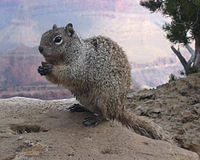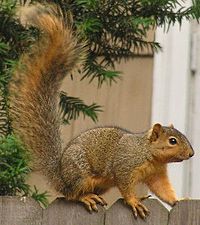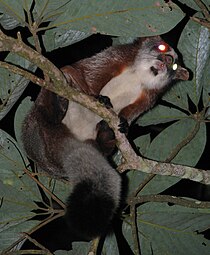
Colugos are arboreal gliding mammals that are native to Southeast Asia. Their closest evolutionary relatives are primates. There are just two living species of colugos: the Sunda flying lemur and the Philippine flying lemur. These two species make up the entire family Cynocephalidae and order Dermoptera.

Flying squirrels are a tribe of 50 species of squirrels in the family Sciuridae. Despite their name, they are not in fact capable of full flight in the same way as birds or bats, but they are able to glide from one tree to another with the aid of a patagium, a furred parachute-like skin membrane that stretches from wrist to ankle. Their long tails also provide stability as they glide. Anatomically they are very similar to other squirrels with a number of adaptations to suit their lifestyle; their limb bones are longer and their hand bones, foot bones, and distal vertebrae are shorter. Flying squirrels are able to steer and exert control over their glide path with their limbs and tail.

The southern flying squirrel or the assapan is one of three species of the genus Glaucomys and one of three flying squirrel species found in North America. It is found in deciduous and mixed woods in the eastern half of North America, from southeastern Canada to Florida. Disjunct populations of this species have been recorded in the highlands of Mexico, Guatemala, and Honduras.

The northern flying squirrel is one of three species of the genus Glaucomys, the only flying squirrels found in North America. They are found in coniferous and mixed coniferous forests across much of Canada, from Alaska to Nova Scotia, and south to the mountains of North Carolina and west to Utah in the United States. They are light brown with pale underparts and grow to a length of 25 to 37 cm. They are proficient gliders but uncoordinated walkers on the ground. They feed on a variety of plant material as well as tree sap, fungi, insects, carrion, bird eggs and nestlings. They mostly breed once a year in a cavity lined with lichen or other soft material. Except when they have young, they change nests frequently, and in winter a number of individuals may huddle together in a shared nest. Unlike most members of their family, flying squirrels are strictly nocturnal.

Sciurinae is a subfamily of squirrels, uniting the flying squirrels with certain related tree squirrels. Older sources place the flying squirrels in a separate subfamily (Pteromyinae) and unite all remaining sciurids into the subfamily Sciurinae, but this has been strongly refuted by genetic studies.

The squirrel glider is a nocturnal gliding possum. The squirrel glider is one of the wrist-winged gliders of the genus Petaurus.

Commonly referred to as the Old World flying squirrels, the genus Pteromys is distributed across temperate Eurasia, the Korean Peninsula and Japan. Although there are a host of flying squirrel genera in Asia, Pteromys is the only one present in Europe.
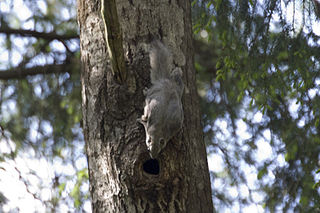
The Siberian flying squirrel is an Old World flying squirrel ranging from the Baltic Sea in the west, throughout Northern Asia to the coast of the Pacific Ocean in the east. It is the only species of flying squirrel in Europe and is considered vulnerable in the European Union where it occurs only in Estonia and Finland. In Latvia, it was last sighted in 2001 and has been considered to be locally extinct since 2013.

A number of animals are capable of aerial locomotion, either by powered flight or by gliding. This trait has appeared by evolution many times, without any single common ancestor. Flight has evolved at least four times in separate animals: insects, pterosaurs, birds, and bats. Gliding has evolved on many more occasions. Usually the development is to aid canopy animals in getting from tree to tree, although there are other possibilities. Gliding, in particular, has evolved among rainforest animals, especially in the rainforests in Asia where the trees are tall and widely spaced. Several species of aquatic animals, and a few amphibians and reptiles have also evolved this gliding flight ability, typically as a means of evading predators.

The Philippine flying lemur or Philippine colugo, known locally as kagwang, is one of two species of colugo or "flying lemurs". It is monotypic of its genus. Although it is called "flying lemur", the Philippine flying lemur is neither a lemur nor does it fly. Instead, it glides as it leaps among trees.

The dwarf scaly-tailed squirrel is a species of rodent in the family Anomaluridae. It is found in Cameroon, Central African Republic, Republic of the Congo, Democratic Republic of the Congo, Equatorial Guinea, Gabon and Uganda. The species is nocturnal and arboreal and lives in subtropical or tropical lowland rainforest. Membranes attached to its limbs and tail enable it to glide between trees. This squirrel is currently not considered to be threatened by habitat destruction; "much of the habitat within parts of the known range of this species is relatively intact, and the species is unlikely to be experiencing any significant declines."

The Indian giant flying squirrel, also called the large brown flying squirrel or the common giant flying squirrel, is a species of rodent in the family Sciuridae. It is capable of gliding flight using a skin membrane stretched between front and hind legs. It is found in mainland Southeast and South Asia, and southern and central China.

Peters's squirrel is a tree squirrel in the genus Sciurus endemic to Mexico. It was first described by the German naturalist and explorer Wilhelm Peters in 1863. Three subspecies are recognised. It is a common species, and the IUCN has rated its conservation status as being of "least concern".

There are at least 50 small mammal species known to occur in Yellowstone National Park.

The Japanese dwarf flying squirrel is one of two species of Old World flying squirrels in the genus Pteromys. During the day this squirrel hides in a hole, usually in a coniferous tree, emerging at night to feed.
The Prince of Wales flying squirrel is a subspecies of the northern flying squirrel endemic to Prince of Wales Island and a few neighboring islands in the Alexander Archipelago of Alaska.

Humboldt's flying squirrel is one of three species of the genus Glaucomys, the only flying squirrels found in North America. The squirrel was named after the naturalist Alexander von Humboldt and California's Humboldt County, which is one of the areas inhabited by the squirrel.
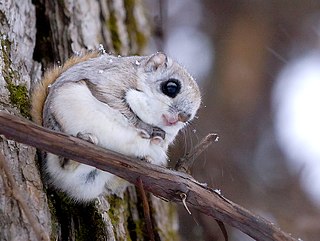
The Ezo flying squirrel or Ezo-momonga is a subspecies of the Siberian flying squirrel. It is endemic to Hokkaidō, Japan, part of the region once known as Ezo. In the legends of the local Ainu, the Ezo flying squirrel or A-kamui is a tutelary deity of children. Together with the Ezo chipmunk and Ezo squirrel, it is one of the three sciurids found on the island, to the north of Blakiston's Line, each having its own particular ecological niche.


















